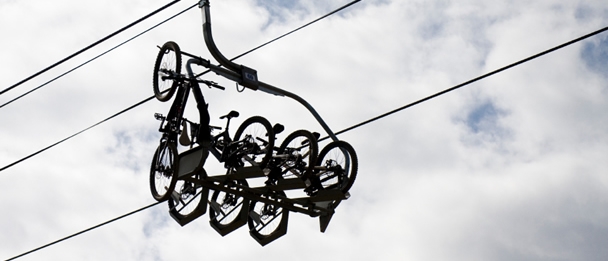Beginners Guide to Bike Parks
17 Nov 2011
By David Scorer

New to bike parks? Here's what you need to know...
Bike Parks are essentially condensed areas of fun from the world of mountain biking, where trail builders are free to experiment to their hearts’ content, inventing wooden obstacles, mounds, wall rides and sculpted runs for riders to test their mettle on. Whatever standard of rider you are, don’t be intimidated, Bike Parks are supposed to be fun. And whether you’re just starting out, or a seasoned pro, there should be something to get the adrenalin pumping. It shouldn't be a complicated affair: most modern parks have a colour-code system, designating the difficulty of runs or individual features (much like an alpine ski resort does), and some BPs have a 'skills area' where you can challenge yourself against the different colour grades to get an approximation of what standard you are. And of course, these are mere guidelines: you’re always free to push your abilities, or downgrade and ride something easier too. To help you get the most out of your next visit to a Bike Park, consider the following terminology and some dos and don'ts
Terminology
A Bike Park is a new world, with its own words, terms and shortcuts to learn. Some unfamiliar terms you might come across are:
A Gravity Park: is a Bike Park on a slope, and as such enables riders to use gravity to propel them at the various obstacles and jumps.
Dirt jumps: are a network of closely-packed, and often quite steep jumps, built so as to get as much air time for the riders in as short a run as possible.
Rhythm section: dirt jumps come in 'sets' (single lines that can be ridden in one go), also known as 'rhythm sections' which means once you start getting air, you'll go again and again and again.
Pump Tracks: are areas in which it is theoretically possible to go from the start point to the finish point without pedaling; relying purely on the ability to ‘pump’ ones bike (by pushing on the handlebars and pedals at strategic points) in order to propel you and your bike forwards. Pump tracks use less-severe mounds of earth in ‘sets’ (like dirt jumps) and bermed corners.
Berm: a berm is a banked turn.
A Chicken Line: is an 'opt-out' line on where you might wish ride around a difficult section or particular obstacle in the Bike Park.
Northshore: is purpose-built terrain (normally from planks of wood or felled logs), that can be ridden over in order to test a riders nerve and balance. The name comes from Vancouver Island's north shore area, where the ground is boggy. Back in the 1990s, this caused the local riders to build bridge after bridge over muddy patches on their trails, and before long, they preferred riding the wood structures to riding over the ground, and northshore riding was born.
Wall Rides: are steep areas, possibly vertical but sometimes near-vertical, with transitioned, graded run-ins that allow riders to ride across the ‘wall’. Even beginners love seeing how far up the wall they dare ride.
Transitions: are the curved radius of ground, dirt or wood between the flat ground and an obstacle that is somewhere close to horizontal. They help one ride smoothly from one axis to another. When halfpipe skateboarders go from horizontal to vertical it’s because they’re riding up (and then down) a transitioned, wooden wall.
A Tabletop: if you were to build a jump with a take off, a middle section that you could walk over, and a landing ramp, you've built a table top.
A Gap Jump: if you were to remove the middle section from a tabletop (see above), you’d have gotten yourself a gap jump. Think of it as an Evel Knievel jump with the busses removed.
A Hip Jump: is one in which the take off and landing are around 45 degrees from each other. So you launch heading straight onwards, and land riding to the left or right.
A Drop: is just that, a height from which one can ride off and ‘drop’ on ones bike.
Dos and Don’ts
Bike Park etiquette is based on common sense, but just to give you the lowdown, here ten tips on what to do, and what not to do.
Do
-
Wear a helmet - in many resorts helmets are mandatory and they won’t let you ride the BP without one. And it’s always good to protect your gray cells too.
-
Follow Bike Park rules - if an obstacle has been closed off, there’s probably a good reason for it. Please read the BP’s rules (normally posted near the entrance) and obey.
-
Look before you leap - check out the jumps before trying them out for the first time. That tabletop could always be a gap jump and you’ll need to know how much speed to take.
-
Push your abilities - but do so in short increments, not huge leaps of faith.
-
Be polite to other riders - they might offer advice on your riding, and it’s nice to keep the vibe in a BP nice and friendly.
Don’t
-
Stop on the top of a jump or on a landing area - other riders might not be able to see you and if they’re in the air, might be unable to avoid you.
-
Damage the terrain - if you accidentally gauge a take-off with your pedal, either tell someone in charge, or try and patch it up yourself.
-
Ride past someone in need of help - what goes around comes around.
-
Forget to try the new obstacles - much thought will have gone into making new challenges for you to try out. Don’t be shy.
-
Walk back up - unless there are specific ‘push up’ tracks, keep flowing in one direction only.

Comments